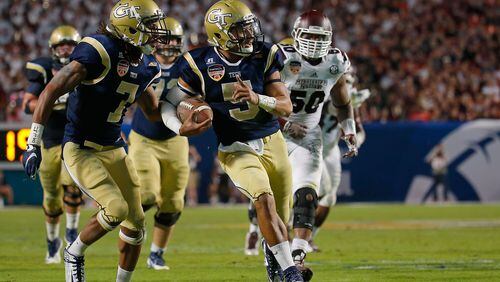Georgia Tech will begin spring practice Monday with the first of 15 practice sessions that will conclude with the spring game April 17 at Bobby Dodd Stadium.
1. For Georgia Tech coaches, the week leading up to spring break concluded a deep self-evaluation of the program, as is standard practice. Recruiting, conditioning, practice – everything went under the microscope. On-field play, also, of course. It involved a self-scout of offense and defense, with breakdowns by type of play, personnel groupings, down-and-distance and other categories.
“We look at everything from schemes to personnel,” coach Paul Johnson said. “We’ll talk about personnel and see if we’ve got everybody in the right spot and how do we get them on the field. We sit there and evaluate practice. How are we doing it? Is there a better way? Is there a better way to do the treatments? Is there a better way to do all of it? It doesn’t mean you’re going to change a lot, but I think it’s worthwhile to look at it.”
Objectives include what can be done better, what can be taught better and perhaps what should be de-emphasized or eliminated. Were there packages that weren’t effective and used too much, or others that were effective and weren’t used enough? Are there wrinkles that need to be explored?
One of the most significant conclusions to come from last year’s assessment was the return to the base offense and the abandonment of the shotgun.
Johnson said that “it wasn’t near as good as people thought it was and it took a lot of practice time from what we were doing. It was a different deal. I don’t think our kids ever really (embraced it). What are we? Are we a gun team? Are we an under-the-center option team?”
Johnson gave no hints in a recent interview at what changes might be in store, but allowed that there were improvements to be made. If, for instance, coaches saw that the defense didn’t play well against a particular personnel package, then periods in spring practice could be devoted to having the first-string offense run plays out of that personnel grouping as a scout team, and vice versa. He was also clear that defensive play had to improve.
2. At least two changes have already been made. Walk-on Brady Swilling has moved from quarterback to B-back, where he'll provide competition for C.J. Leggett and early-enrollee freshman Quaide Weimerskirch. Johnson said that Swilling had added weight (he's listed at 213 pounds in the spring prospectus). Qua Searcy has moved to A-back from wide receiver, a switch Johnson mentioned on signing day.
Leggett, Weimerskirch and Swilling figure to get all the snaps they could want, and the same goes for A-backs Dennis Andrews, Clinton Lynch, Searcy, Isiah Willis and Austin McClellan. (Broderick Snoddy is recovering from a broken tibia/fibula, but likely won't be available for the spring.) One more interesting switch: walk-on Roberto Hinojosa, who was a backup kicker last fall, has moved to A-back. There is no shortage of opportunity at A-back, although signees KirVonte Benson, Nate Cottrell, Omahri Jarrett, Marcus Marshall and possibly TaQuon Marshall will challenge for practice time in preseason camp.
3. Tech's offensive-line depth will be useful with center Andrew Marshall and offensive tackle Chris Griffin out for the spring after having unspecified surgeries (defensive lineman Tyler Stargel is also out). Both could have used the practice repetitions – both just completed their freshman seasons – but other younger linemen such as Trey Klock, Gary Brown, Michael Preddy and Eason Fromayan could benefit.
“We may slide some guys around during spring,” Johnson said. “Guys who played tackle may be playing guard and different things.”
It will be an important spring for guard Shamire Devine, who will be in position to win the vacant guard spot. Devine has the size and talent, but will need to build up his conditioning.
4. Johnson said at the pro day that backup quarterback Matthew Jordan is "going to get a lot of reps." Johnson said that it doesn't make sense to "beat up" starter Justin Thomas, or backup Tim Byerly, for that matter.
“We think he’s proven what he can do a little bit, and really, for that matter, so has Tim Byerly,” he said.
Tech is in a far different position than a year ago, when uncertainty surrounded the quarterback spot.
5. A lot of eyes will be on defensive end Jabari Hunt-Days, who is trying regain academic eligibility while competing for playing time. Hunt-Days received a slew of positive reviews for his work on the defensive scout team last year. Guard Shaquille Mason said he was the best defensive lineman he faced in the 2014 season and credited him with helping play at an All-American level.
With the expected progress of defensive end KeShun Freeman, the addition of Hunt-Days would help make a formidable unit with Adam Gotsis and possibly Patrick Gamble inside.
About the Author







